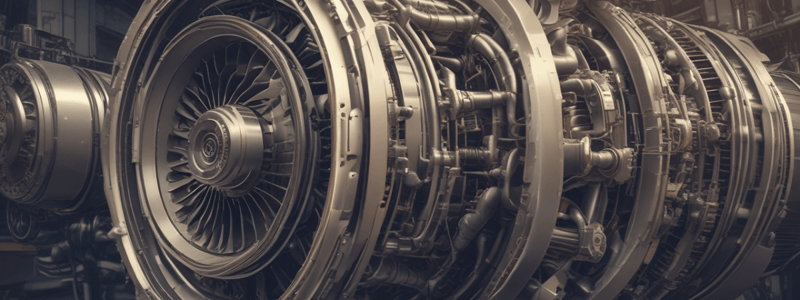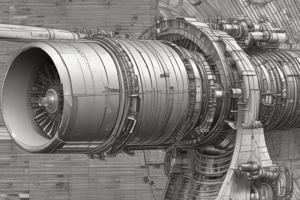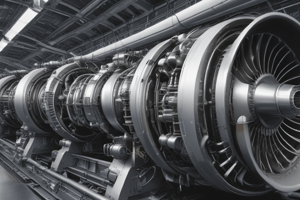Podcast
Questions and Answers
What is the primary source of power for a gas turbine engine during flight?
What is the primary source of power for a gas turbine engine during flight?
- Ram effect of the incoming air (correct)
- Electric motor
- Turbine wheel
- Compressor impeller
What type of turbine wheel is used in the pure reaction turbojet engine?
What type of turbine wheel is used in the pure reaction turbojet engine?
- Radial turbine wheel
- Multi-stage turbine wheel
- Single-stage turbine wheel (correct)
- Axial turbine wheel
What is the purpose of the combustion chamber in a gas turbine engine?
What is the purpose of the combustion chamber in a gas turbine engine?
- To burn the air/fuel mixture (correct)
- To extract energy from the exhaust gases
- To compress the air
- To generate electricity
What is the name of the British Royal Air College cadet who patented the first turbojet aircraft engine?
What is the name of the British Royal Air College cadet who patented the first turbojet aircraft engine?
What is the working fluid used in an aircraft gas turbine engine?
What is the working fluid used in an aircraft gas turbine engine?
What is the primary function of the compressor in a gas turbine engine?
What is the primary function of the compressor in a gas turbine engine?
What is the primary function of the gas generator in a turboshaft engine?
What is the primary function of the gas generator in a turboshaft engine?
What is the main difference between a fixed turbine and a free turbine turboshaft engine?
What is the main difference between a fixed turbine and a free turbine turboshaft engine?
Which of the following is NOT a common application of turboshaft engines?
Which of the following is NOT a common application of turboshaft engines?
What is the primary purpose of an aircraft auxiliary power unit (APU)?
What is the primary purpose of an aircraft auxiliary power unit (APU)?
How many types of gas turbine-powered jet engines are commonly used in today's aircraft?
How many types of gas turbine-powered jet engines are commonly used in today's aircraft?
What is the name of the turbine that drives the free turbine system in a turboshaft engine?
What is the name of the turbine that drives the free turbine system in a turboshaft engine?
What is the primary purpose of the compressor in a turbojet engine?
What is the primary purpose of the compressor in a turbojet engine?
What is the result of the heat generated by the burning fuel in a turbojet engine?
What is the result of the heat generated by the burning fuel in a turbojet engine?
What is the ratio of airflow in a low-bypass engine?
What is the ratio of airflow in a low-bypass engine?
What is the main advantage of the turbojet engine?
What is the main advantage of the turbojet engine?
What is the term for the air that passes through the core engine in a low-bypass engine?
What is the term for the air that passes through the core engine in a low-bypass engine?
What is the advantage of a mixed exhaust design in a low-bypass engine?
What is the advantage of a mixed exhaust design in a low-bypass engine?
What is the primary difference between a turbojet engine and a turbofan engine?
What is the primary difference between a turbojet engine and a turbofan engine?
What is the result of the air exiting the engine at a higher velocity than the incoming air?
What is the result of the air exiting the engine at a higher velocity than the incoming air?
What is the fan ratio of a high-bypass engine?
What is the fan ratio of a high-bypass engine?
What is the current trend in commercial and business jets in terms of engine choice?
What is the current trend in commercial and business jets in terms of engine choice?
What is required to accomplish the high-bypass ratio in a high-bypass engine?
What is required to accomplish the high-bypass ratio in a high-bypass engine?
What is the term for the air that is discharged by the fan and ducted overboard from a short duct?
What is the term for the air that is discharged by the fan and ducted overboard from a short duct?
What percentage of the airflow accelerated by the fan rotor blades is ducted past the core engine?
What percentage of the airflow accelerated by the fan rotor blades is ducted past the core engine?
What is the purpose of the pressure within the fan duct in ducted fan engines?
What is the purpose of the pressure within the fan duct in ducted fan engines?
Why do high-bypass engines and ducted fan engines produce more fan thrust than low-bypass engines?
Why do high-bypass engines and ducted fan engines produce more fan thrust than low-bypass engines?
What is the purpose of the engine station reference system?
What is the purpose of the engine station reference system?
What is the term for the airstream that is ducted overboard, either directly behind the fan or at the rear of the engine?
What is the term for the airstream that is ducted overboard, either directly behind the fan or at the rear of the engine?
What is an alternative arrangement of the fan, where it is powered by a shaft from the turbine or is an extension of the turbine blades?
What is an alternative arrangement of the fan, where it is powered by a shaft from the turbine or is an extension of the turbine blades?
Flashcards are hidden until you start studying
Study Notes
Bypass Ratios
- Low-bypass engine: airflow is divided approximately into two halves between the fan and compressor
- Medium-bypass engine: 2:1 or 3:1 ratio
- High-bypass engine: 4:1 to < 9:1 ratio
- Ultra-high-bypass engine: > 9:1 ratio
Low-Bypass Engine
- Air is divided into two halves: fan and compressor
- Fan air may be ducted overboard or pass through the core engine
- Core engine air is compressed, combusted, and discharged through the hot exhaust nozzle
- Turbofan engine can have non-mixed or mixed exhaust
- Mixed exhaust design offers noise suppression by diluting hot gases
High-Bypass Engine
- Fan ratio: 4:1 to < 9:1 (four to nine parts of air go through the fan for every part that goes to the core engine)
- Requires a large-diameter fan
- Example: diagram showing changes in pressure, velocity, and temperature during ground run-up
History of Propulsion
- Frank Whittle, British Royal Air College cadet, wrote a thesis advocating for the use of gas turbine engines in 1930
- Whittle patented the first turbojet aircraft engine, which used a compressor impeller driven by a turbine
- The engine developed was a pure reaction turbojet, where total thrust came from reaction to the hot gas stream
Gas Turbine Engine
- The aircraft gas turbine is a heat engine using air as a working fluid
- Consists of a compressor, combustion chamber, and turbine
- Four types of gas turbine engines: turboshaft, turbo-propeller, turbojet, and turbofan
Turboshaft Engine
- Delivers power through a shaft to operate something other than a propeller
- Can be a fixed turbine or free turbine turboshaft engine
- Free turbine turboshaft engine has two major sections: gas generator and free turbine
- Used in industrial applications, such as electrical power-generating plants and surface transportation systems
- Also used in aviation, particularly in helicopters and aircraft auxiliary power units (APUs)
Turbojet Engine
- Uses the acceleration of airflow throughout the engine to produce thrust
- Well suited for high-speed, high-altitude operations
- Basic operating principles: air enters through an inlet duct, is compressed, mixed with fuel, and ignited
- Expanding air spins turbine wheels, which drives the compressor, and exits the engine at a higher velocity
Turbofan Engine
- Consists of a multi-bladed ducted propeller driven by a gas turbine
- Up to 90% of airflow accelerated by the fan rotor blades is ducted past the core engine
- Fan tip speed may exceed Mach 1 to deliver the correct amount of air
- High-bypass engines and ducted fan engines produce more fan thrust than low-bypass engines
Engine Stations
- Reference system using engine stations to identify the position of a component or fitting
- Engine stations follow the gas path and refer to basic locations such as the compressor inlet, compressor outlet, and turbine inlet and outlet
- Number of designated stations varies according to engine complexity
Studying That Suits You
Use AI to generate personalized quizzes and flashcards to suit your learning preferences.




